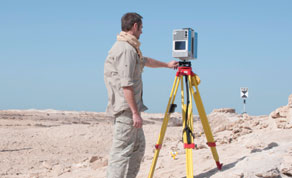 A 3D laser scanner in use at Al Zubarah Archaeological Site on the northwest coast of Qatar to record walls and buildings (left) and conservation work progressing in Al Zubarah Fort, which is now closed to visitors (below). Al Zubarah Archaeological Site, hopefully going to place Qatar for the first time on the Unesco World Heritage List, is being explored with cutting edge technology to seek unprecedented insights from the past. Researchers from the University of Copenhagen, commissioned by the Qatar Museums Authority, are conducting geophysical survey and 3D laser scanning alongside ongoing excavations to learn more about the Gulf’s most complete and well-preserved pearl
A 3D laser scanner in use at Al Zubarah Archaeological Site on the northwest coast of Qatar to record walls and buildings (left) and conservation work progressing in Al Zubarah Fort, which is now closed to visitors (below). Al Zubarah Archaeological Site, hopefully going to place Qatar for the first time on the Unesco World Heritage List, is being explored with cutting edge technology to seek unprecedented insights from the past. Researchers from the University of Copenhagen, commissioned by the Qatar Museums Authority, are conducting geophysical survey and 3D laser scanning alongside ongoing excavations to learn more about the Gulf’s most complete and well-preserved pearl
trading and diving town of the 18th-19th centuries. Experts from Posselt & Zickgraf Prospektionen GbR, a company specialising in archaeological geophysics, have for the first time begun to use magnetometers  and ground penetrating radar. The specialist team from the HafenCity University Hamburg has been called in to record the archaeological remains through 3D laser scanning as well. PICTURES: Dan Britton
and ground penetrating radar. The specialist team from the HafenCity University Hamburg has been called in to record the archaeological remains through 3D laser scanning as well. PICTURES: Dan Britton



